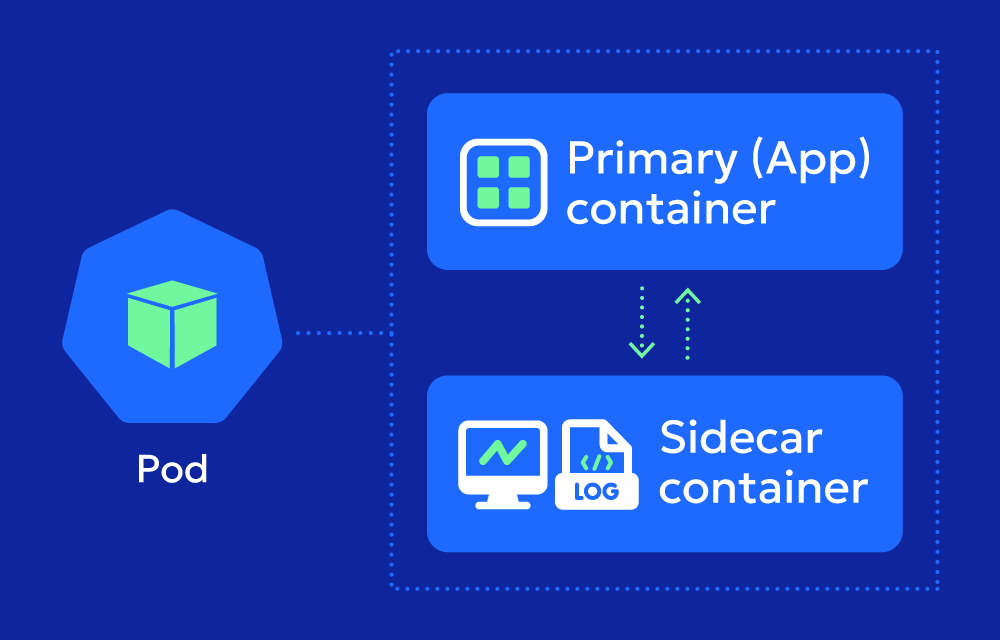How Sidecar Containers Work
Sidecar containers run in the same pod as the main container, sharing the pod’s network, storage volumes, and lifecycle. This proximity allows them to seamlessly interact with the main container and other system components.
They can for example:
- Forward logs from the application to a centralized logging system.
- Manage communication between the application and external services through a proxy.
- Regularly fetch and inject updated configurations into the application.
By decoupling these secondary tasks, the application container remains lightweight, efficient, and focused on its primary function.
Why Use Sidecar Containers?
Sidecar containers are integral to building scalable, modular, and maintainable Kubernetes architectures. They provide flexibility by isolating operational concerns from the core application, enabling:
- Seamless Integration of Auxiliary Services:
Add new features like metrics collection or traffic encryption without modifying application code. - Ease of Maintenance and Updates:
Update or replace the sidecar container independently of the main application. - Improved Modularity and Reusability:
Use prebuilt sidecars across multiple applications to reduce duplication and speed up development.
Use Cases
- Log Aggregation and Processing:
- Example: Fluentd or Logstash sidecars collect and forward logs to centralized systems like Elasticsearch or Splunk.
- Service Mesh Integration:
- Example: Envoy sidecars enable service discovery, traffic routing, and security policies in service meshes like Istio.
- Monitoring and Metrics Collection:
- Example: Prometheus exporters run as sidecars to expose application metrics for observability platforms.
- Dynamic Configuration Management:
- Example: A sidecar container syncs updated configuration files from external sources to shared volumes, allowing the application to adapt without restarting.
- Secrets Management:
- Example: Vault agents inject sensitive data like API keys or database credentials into the pod securely.
Challenges
- Resource Overhead:
- Running additional containers in a pod increases CPU and memory usage.
- Complexity in Debugging:
- Issues within the sidecar can affect the entire pod, making troubleshooting more challenging.
- Deployment Management:
- Requires careful coordination to ensure sidecars and main containers are compatible and optimized for the same lifecycle.
Best Practices
- Clearly Define Roles:
- Ensure each sidecar container has a single, well-defined purpose to prevent unnecessary complexity.
- Monitor Resource Usage:
- Allocate sufficient CPU and memory to sidecar containers to avoid impacting the main application.
- Design for Loose Coupling:
- Sidecars should operate independently of the main application to minimize cascading failures.
- Test Thoroughly:
- Validate sidecar integrations in staging environments to avoid disruptions in production.
Examples of Sidecar Containers
- Envoy Proxy:
- Used in service meshes to handle advanced networking tasks like load balancing and traffic encryption.
- Fluentd:
- Collects logs from the application and sends them to a logging system like Elasticsearch.
- Prometheus Exporters:
- Gathers metrics from the application and exposes them to monitoring tools.
- Vault Agent:
- Injects secure credentials and secrets into the application.
What is the Difference Between a Sidecar Container and an Init Container?
| Aspect | Sidecar Container | Init Container |
|---|---|---|
| Purpose | Runs alongside the main container to provide continuous support. | Executes setup tasks before the main container starts. |
| Lifecycle | Runs for the duration of the pod. | Terminates after completing its task. |
| Use Cases | Logging, monitoring, proxying, secrets injection. | Dependency checks, database migrations, file extraction. |
| Example | Fluentd for log forwarding. | Initializing shared volumes with configuration files. |
| Interaction | Shares resources with the main container and can run concurrently. | Runs sequentially before the main container starts. |
Further Reading
- Kubernetes Documentation on Sidecar Containers
- Deep Dive into Sidecar Containers
- Service Mesh and Sidecar Examples in Istio
Sidecar containers are a powerful pattern in Kubernetes, providing flexibility and functionality to modern applications without bloating the core application logic. By understanding their uses and best practices, you can make your Kubernetes deployments more modular, scalable, and efficient.



